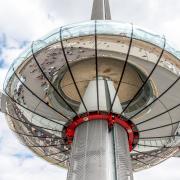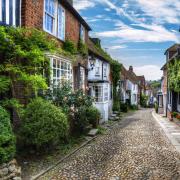THE GEORGE HOTEL
The George Hotel dominates the High Street and is arguably the town’s single most famous building. Given Crawley’s position roughly halfway between London and Brighton, this was the most important and successful coaching inn in the county during its heyday. The main part of the building’s interior dates from 1615 and the distinctive wooden structure that spans the street outside is a replica of the gallows that stood here from about 1690 until it was replaced in the 1930s.

CRAWLEY ORIGINS
Crawley’s name derives from the ancient words for a wood filled with crows - a crow lea. This sculpture in the High Street by Joss Smith, called The Golden Tree, celebrates this heritage.

PUNCH BOWL
One of the oldest, best-preserved buildings in the town, The Old Punch Bowl now operates as a pub. Dating from the early 1400s, it is a classic timber-framed Wealden Hall house, of the kind found all over our county. Over the centuries, it’s been a farmhouse, private housing, a tearoom and even a bank, which it was until it became a pub in 1994.

ANCIENT PRIORS
Another medieval building dating from the 1400s is the Ancient Priors building on the High Street, once described as ‘the finest timber-framed house between London and Brighton’. In the late 1970s, it was bought and operated as a restaurant by local boxer Alan Minter, soon to become the Middleweight champion of the world. Nowadays it’s in use as an Italian restaurant and a solicitor’s office.

THE FIRST SUPERSTORE
The Decathlon store, in one corner of Queens Square, was originally opened in 1959 as The Queensway Store and, at the time, was Britain’s most modern department store. There was even a cafe on the fourth-floor balcony - truly the height of sophistication. In 1968, the building was taken over by Tesco who coined a new word to describe it: this was Britain’s first ‘superstore’.

THE BANDSTAND
The Bandstand was made in 1891 and erected at Gatwick Racecourse, which was then an important race venue - it hosted the Grand National three times during the Great War. When Gatwick airport opened in 1933 the bandstand was removed and put into storage. Crawley Development Corporation bought it and put it in the middle of Queens Square, where it stayed until 2016 when it was removed , renovated and re-erected in the Memorial Gardens. If you look on YouTube, you can find footage of The Cure playing on it in Queens Square in 1977.

TILGATE PARK
Crawley is lucky to have Tilgate Park, a fantastic outdoor space for everyone in the town to enjoy. Once it was land belonging to the Ashburner-Nix family with the centrepiece being the enormous French-style mansion called Tilgate House. After the family found themselves in difficulties before the last war, the whole estate was put up for sale and, eventually, the mansion was demolished. The lake in this picture was once known as Campbell’s Lake after Sir Donald Campbell used the water as a flotation test for his famous boat Bluebird.

GOFFS MANOR
Goffs Manor is a traditional-style old pub on the Old Horsham Road but despite appearances, it wasn’t always so. In the 1970s and 80s this 16th century half-timbered farm building was the home of actor Peter Vaughan who was well-known for playing the genial old lag Harry Grout in Ronnie Barker’s prison comedy Porridge.

PARISH CHURCH OF ST NICHOLAS
The Parish Church of St Nicholas in Worth was established in the year 950, making this the 11th oldest place of worship in the country, with stories of connections to the last Saxon king of England, Edward the Confessor and William the Conqueror. It is an extraordinarily atmospheric building, most of which dates right back over those thousand years. It’s also where Robert Smith of The Cure got married.

THE BEEHIVE
Sitting in the middle of an industrial estate on the edge of town is The Beehive, the original terminal building for Gatwick Airport which opened in 1936. It was the first integrated airport building, with six telescopic covered corridors that led to one of the aircraft that could park at the terminal building. There were concentric rings built in to keep arriving and departing passengers separate and there was a subway to the railway station so passengers would, in the event of rain, remain dry. The centre of the building rises to the control tower in the centre. With the expansion of Gatwick in the 1950s, this beautiful building, sadly, became redundant.

LOCAL RESIDENT JO PETTIPHER
I came here for my job at the museum and I fell in love with the place. There is such a positive vibe about it. My job is about making sure people don’t forget about the history of Crawley and everything it’s been through. It would be nice to renovate the empty buildings and put markers in the pavement in places where incredible historical things have happened. These things should be pointed out.’



























